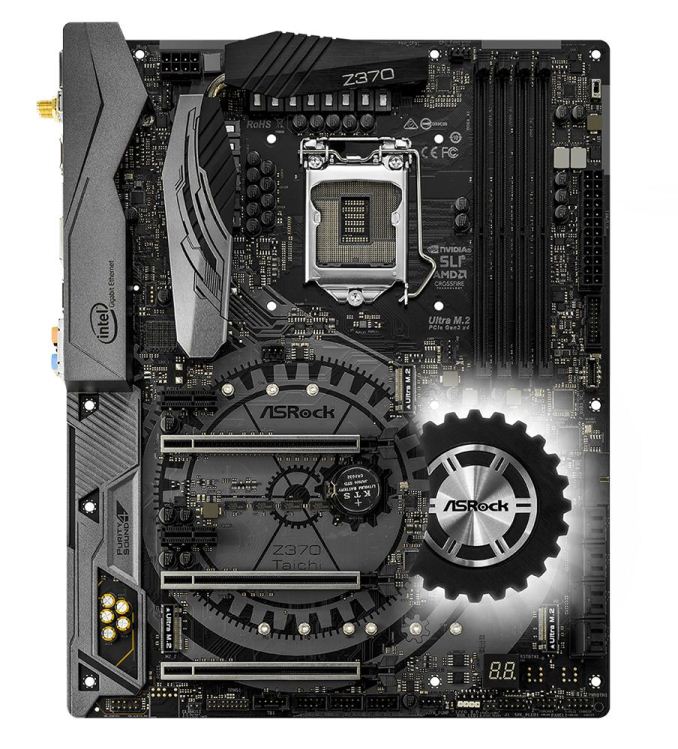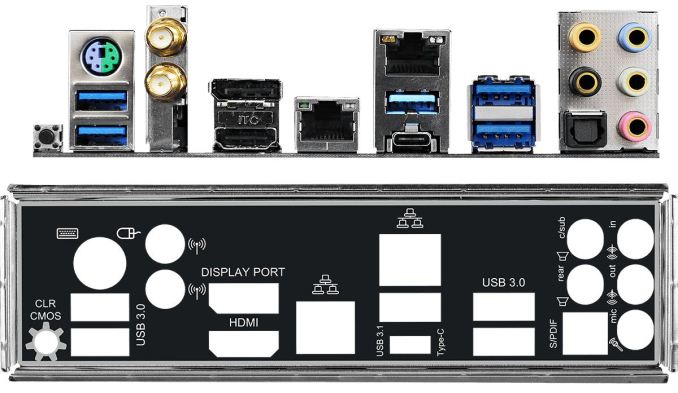Analyzing Z370 for Intel's 8th Generation Coffee Lake: A Quick Look at 50+ Motherboards
by Ian Cutress, Anton Shilov, Joe Shields & Gavin Bonshor on October 20, 2017 2:00 PM ESTASRock Z370 Taichi
In a board that stands in the ASRock's 'upper mid-range' class on its own, the Taichi name lives on another generation in the Z370 Taichi. As with those that came before it, Taichi boards are aimed to be balanced, and do not show a propensity to lean in any which way: gaming, workstation, overclocking, it could (like many other motherboards) do it all. The Z370 version won’t stray from that target either.
The Z370 Taichi looks almost the same as its bigger brother on the X299 platform. The same cog or gear artwork is featured prominently in grey against the all black PCB. The back panel and audio section are covered with the same style shroud from the X299 Taichi. The large VRM heatsinks from the Gaming i7 and Gaming K6 also find their way to the Taichi but in black instead of grey. The chipset heatsink, also in the shape of a gear, is the only place on the board to find RGB LEDs. Users are able to add more color via an LED strip through the onboard header.
The four memory slots provide support for 64GB, with speeds up to DDR4-4333. The Taichi has three reinforced full-length GPU slots, capable of x16 in single card, x8/x8 with two cards, and x8/x4/x4 in three card mode, meaning the board supports both 2-way SLI and 3-way Crossfire. There are also two open-ended PCIe x1 slots, powered from the chipset.
The board offers six SATA ports from the chipset, two SATA ports from an additional controller, and three M.2 slots. The bottom two M.2 devices support up to 110mm while the top supports up to 80mm. The slots do share lanes, so that if the first M.2 slot is populated, SATA 0/1 are disabled. If the second M.2 slot is in use, SATA 4/5 are disabled. Last, if the third M.2 slot is populated by a SATA type M.2 device, SATA3 is disabled, so be aware.
The board has five 4-pin fan headers in various locations around the board to allow for BIOS or F-Stream software control in Windows. The CPU Optional and Chassis Optional pumps both deliver 1.5A/18W to the headers, for powering pumps from AIOs or custom built loops. The same audio found on the higher end boards also made it over to the Taichi via the Realtek ALC1220 codec, and uses Nichicon Gold series audio caps as well as a Texas Instruments NE5532 headset amplifier. Two Intel Ethernet controllers, the Intel I219-V and Intel I211-AT, and an Intel W-Fi module, make up the network side. As with nearly all the ASRock boards, Thunderbolt support is handled by a 5-pin add-in-card connector.
USB connectivity on the back panel IO consists of a USB 3.1 (10 Gbps) Type-A port and Type-C port from an ASMedia ASM3142, as well as four USB 3.1 (5 Gbps) ports from the chipset. A front panel USB 3.1 (10 Gbps) header is found internally, along with three USB 2.0 headers (chipset) and two more USB 3.1 (5 Gbps) headers (ASM1074 hub). The remainder of the back panel IO contains a Clear CMOS button, a combination PS/2 port, DisplayPort and HDMI, and audio jacks plus SPDIF.













83 Comments
View All Comments
weevilone - Wednesday, October 25, 2017 - link
Notable that though the new boards are often very similar to their Z270 predecessors, Asus has dropped Thunderbolt 3 support from the Maximus X Hero board.masouth - Thursday, October 26, 2017 - link
ASUS ROG Z370 Maximus X Hero"....new metallic heat sinks that are an upgrade over the plastic heatsinks found on the Z270 version"
Please excuse my ignorance because I didn't own a ROG Z270 mb but...plastic HEAT SINKS? Not shrouds or decoration over a heat sink but the actual heat sinks themselves? That's either wrong, they performed their job pretty poorly, or plastic resins have advanced a lot farther in thermal conductivity (and cost for such) than I realized.
flowrush - Sunday, November 19, 2017 - link
"The other main distinguishable feature is the inclusion of integrated 802.11ac Wi-Fi with an antenna (that can only be described as a shark fin) found on the F."The above is incorrect in the article. The integrated Wi-Fi module with antenna is found on the E not the F.
Coldgame - Saturday, November 25, 2017 - link
I'm looking to build a rig with the Z370 Gaming ITX/ac, a GTX-1070 card and an Apple Thunderbolt Display.The review states:
"The key difference in the support between the two boards is going to be the Thunderbolt 3 port on the Gaming-ITX. This port supports video outputs..."
So, can anyone confirm or deny that video generated by the GTX-1070 can be output through the onboard Thunderbolt 3 port?
hanselltc - Sunday, December 3, 2017 - link
Looking forward to low-middle end mITX choices from this platform. It'll probably be paired with a 8100/8300 and be my secondary machine.Roen - Sunday, February 4, 2018 - link
Where are the 10 Gbps ports on the back? They all look like 5 Gbps ports, even the Type C.rbarak - Wednesday, February 21, 2018 - link
Is anyone using the Z370-P on Linux with two screens?I built a new machine based on the Z370-P, and both the DVI and the HDMI connected screens show the same image, and the RHEL7 setup/displays show only one Unknown Display.
I follwed the advice on stackexchange, and added this line:
$ grep GRUB_CMDLINE_LINE_DEFAULT /etc/default/grub
GRUB_CMDLINE_LINE_DEFAULT="i915.alpha_support=1"
Then I did:
sudo grub2-mkconfig -o "$(readlink /etc/grub2.conf)"
And rebooted, but still, the two displays are not shown.
dromoxen - Wednesday, May 9, 2018 - link
Shocked to see that both the Asrock mitx boards are "szie=ATX" .. LOLThe addition of Tunderbolt sure seems to add a hefty premium £120 vs £160 , luckily I can do without.
Kroebo - Sunday, October 7, 2018 - link
Sadly, I discovered that the ZUG Gaming PLUS doesn't support SLI.trag - Tuesday, January 15, 2019 - link
On the ASrock Z370M Pro4 the M.2 slot information is backwards. Both slots support NVME. One slot also supports SATA. As written, "The first M.2 slot is SATA only while the second supports PCIe." it seems to say that one slot is SATA only and the other slot is PCIe (NVME) only.